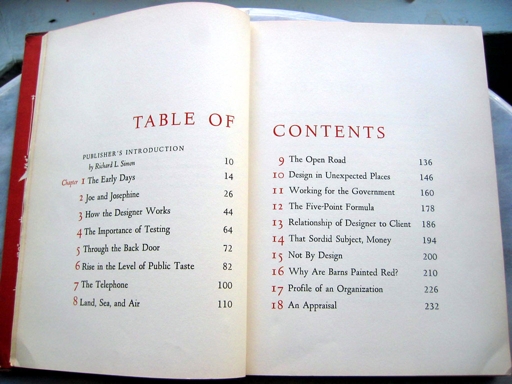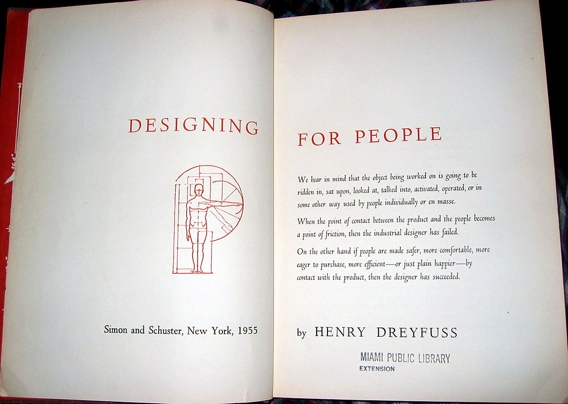January 22, 2004
Designing for People, Chapter 2: Joe and Josephine
Don Norman deservedly gets a lot of credit for making people aware of the need for user-centered design with his seminal book "The Design of Everyday Things," published in 1988. But 33 years before then, Henry Dreyfuss was talking up this philosophy, and his devotion to it is made clear when he devotes his second chapter to Joe and Josephine -- the archetypal people for whom Dreyfuss creates all his designs.

Josephine and Joe, Jr. Click image to enlarge.
(These creations were given their own book, The Measure of Man and Woman: Human Factors in Design)
The product of extensive research with human physiology, these personas helped Dreyfuss and his team design products that respond to actual physical form. Such data aided in the design of everything from a steam iron to a tank.
And the research isn't limited just to physical motor capabilities. All the senses are considered, particularly vision. And vision isn't just about how we see (or don't see, as with color-blindness), but the cognitive and emotional effect that what we see can have on us.
Where Dreyfuss falls short, and where Don picked up, is understanding the cognitive processes that allow us to make sense of the world. Still, this work in early human factors was ground-breaking, and if designers today paid more attention to this decades-old understanding, we users of products would be a lot less frustrated.
Oh, and I just love this little illustration from page 31.

One annoying-though-at-times-endearing thing about a book written in 1955 by a man who design products for a consumer audience is how it unabashedly uses gender stereotypes, particularly with women, who are depicted cleaning, ironing, being a telephone operator, etc.
January 19, 2004
Designing for People - Chapter 1. The Early Days
...it is better to be right than to be originalDreyfuss recounts his early days in practice, and addresses how the discipline has evolved, and his philosophy towards work. His first industrial design job offer was to improve merchandise at Macy's -- find items that lacked appeal and sketch out improvements. He declined the work because second-guessing the work of the manufacturers is unfair. He states, "An honest job of design should flow from the inside out, not from the outside in."
And he's adamant that a designer must appreciate all aspects of the business.
He does more than merely design things. He is a businessman as well as a person who makes drawings and models. He is a keen observer of public taste and he has painstakingly cultivated his own taste. He has an understanding of merchandising, how things are made, packed, distributed, and displayed. He accepts the responsibility of his position as liaison linking management, engineering, and the consumer and co-operates with all three.
And when it comes to the work of design:
The industrial designer began by eliminating excess decoration, but his real job began when he insisted on dissecting the product, seeing what made it tick, and devising means of making it tick better -- then making it look better. He never forgets the beauty is only skin-deep...He brings to this task a detached, analytical point of view. He consults closely with the manufacturer, the manufacturer's engineers, production men, and sales staff... He will compromise up to a point, but he refuses to budge on design principles he knows to be sound...I don't know about you. I find that inspiring.
He wraps up the chapter with a drawing that illustrates his perhaps-not-politically-correct sentence:"He must be part engineer, part businessman, part salesman, part public-relationsman, artist, and, almost, it seems at times, Indian chief."

Reading this first chapter really wins me over to Dreyfuss' point of view. A clear-headed marriage of pragmatism and enthusiasm, he aligns the realities of the business context in which design occurs with the creative delight that sparks us all. It saddens me to see how the word "designer" continues to be distorted, construed to simply mean "form-maker" and, typically "pretty-maker", and that when non-designers speak of the "design" of something, it's almost always about appearance. (Designers, graphic designers in particular, share a lot of the blame for this pejoration.)
January 18, 2004
Designing for People - Introduction and Initial Thoughts
My corporate-sponsored New Years resolution is to rekindle my passion for user experience work. A key aspect of that plan is to reread works that have fired me up in the past. As I do so, I'll transcribe passages and write up thoughts.
The first book I am dipping back into is Henry Dreyfuss' Designing for People. Henry Dreyfuss is probably the premier American industrial designer of the 20th century, working on projects ranging from commercial to governmental to military. Personal favorite designs include the Bell telephone and the Big Ben alarm clock (featured on the cover of his biography). His design firm lives on (though, sadly, they seem to think that an "under construction" notice suffices. Though, Google pointed me to the old pages that are still live, just not linked to.)
Written in 1955, Designing for People captures Dreyfuss' thoughts, philosophies, and processes as an industrial designer. I first stumbled across this at the San Francisco Public Library, and then spent a few years tracking down an affordable used copy. Nearly 50 years old, it's an eye-opening work -- the leading practitioner of industrial design is essentially writing a how-to on business-savvy user-centered design. And does so in plain-talking, buzzword-free style that communicates simply.
In future posts I'll be exploring the content chapter by chapter, but here I want to address the book's design. It's gorgeous. Stately typography and layout. Two-color printing to emphasize key aspects. Marginalia that illustrates concepts from the text. Pseudo-hypertextuality with call-outs to pages elsewhere in the book. Again, it's 50 years old, but feels remarkably modern.

The Table of Contents sets the typographic tone. Click image to enlarge.
When I first planned this series of write-ups, it was under the assumption that you wouldn't be able to read the book yourself -- it had been out of print for years, and available only through second-hand stores (and often at a high price). That changed late last year when Allworth Press re-released it in paperback. I haven't seen this new printing, so I don't know how true it remains to the design details of the original, but I'm sure it's worth picking up.
I'll leave you with the title page, and a transcription of it's text:

Click image to enlarge.
We bear in mind that the object being worked on is going to be ridden in, sat upon, looked at, talked into, activated, operated, or in some other way used by people individually or en masse.When the point of contact between the product and the people becomes a point of friction, then the industrial designer has failed.
On the other hand if people are made safer, nore comfortable, more eager to purchase, more efficient--or just plain happier--by contact with the product, then the designer has succeeded.

